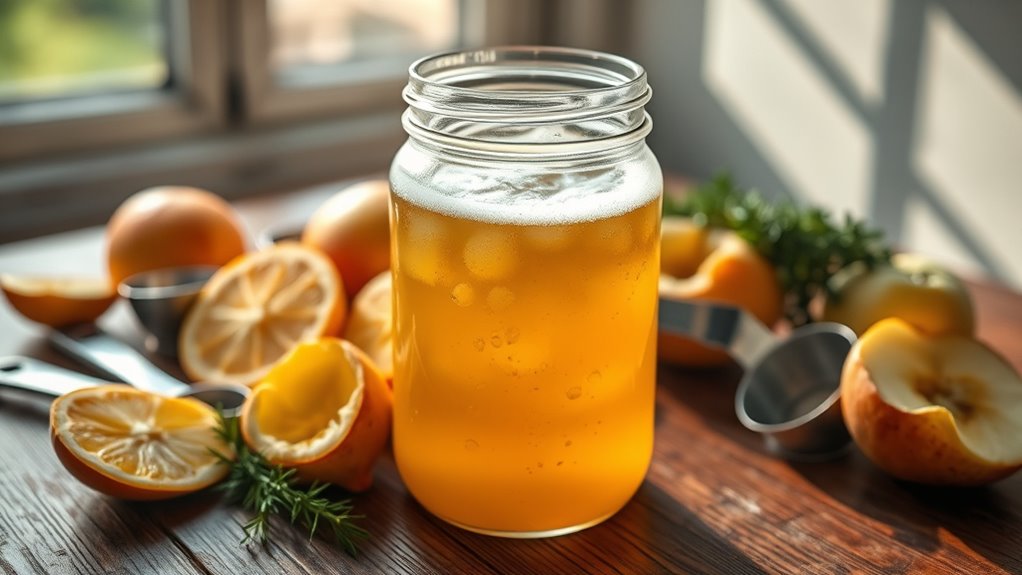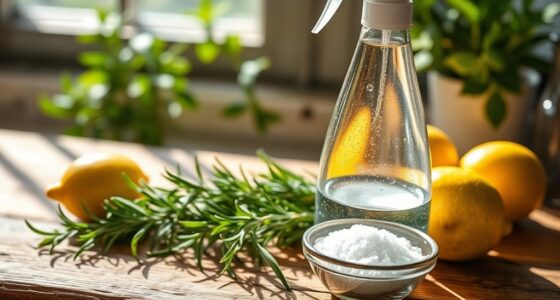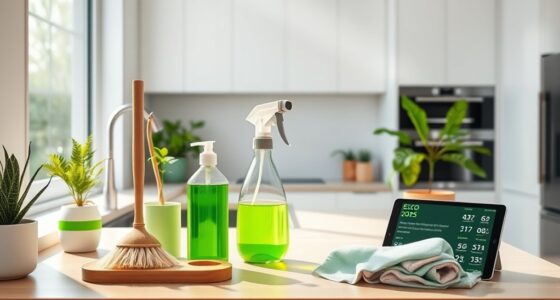A DIY enzyme cleaner is a natural, homemade solution that uses fermented fruit scraps and sugar to create powerful enzymes that break down stains and odors. To make it, mix fruit peels, sugar, and water in a jar, then let it ferment in a warm, dark place for 2-3 weeks until it develops a fizz and a sweet smell. Once ready, strain the liquid and use it directly on problem areas. Keep exploring to learn more tips and tricks.
Key Takeaways
- DIY enzyme cleaner is a natural solution made by fermenting fruit peels, sugar, and water to produce enzymes that break down stains and odors.
- The mixture is fermented for 2-3 weeks in a dark, warm place until it develops a mild smell and slight fizz, indicating readiness.
- Once fermented, strain the liquid to remove solids and transfer it into spray bottles for use on stained or odorous surfaces.
- Spray the enzyme cleaner directly onto stains or odors, allowing it to sit for a few minutes for effective cleaning.
- It is safe, biodegradable, and eco-friendly, making it an effective alternative to chemical cleaners for organic stain removal.

If you’re looking for an effective and eco-friendly way to tackle stubborn stains and odors, making your own enzyme cleaner is a simple and affordable solution. Unlike harsh chemical cleaners, enzyme cleaners harness natural ingredients to break down organic matter, making them safe for both your home and the environment. To create your own, you’ll need a few basic supplies and a bit of patience. The key is understanding the right cleaning techniques and ingredients that activate enzymes to digest stains and odors at their source.
Start by gathering natural ingredients such as fruit peels, sugar, and water. These ingredients are rich in natural enzymes that work to decompose organic waste. For example, banana peels, pineapple skins, or apple scraps are excellent sources of natural enzymes. You’ll also need a jar or bottle with a lid to hold your mixture. The process involves fermenting these ingredients, which produces enzymes capable of breaking down proteins, fats, and carbohydrates in stains and odors.
Gather fruit peels, sugar, and water to create natural enzyme cleaners at home.
To make your enzyme cleaner, combine roughly one part fruit scraps with two parts sugar and fill the jar with water. Seal it tightly and store it in a warm, dark place for about two to three weeks. During this fermentation period, natural bacteria and enzymes develop, transforming the mixture into a powerful cleaning agent. Remember, patience is key; you’ll know it’s ready when it emits a slight fizz and a mild, sweet smell. This fermentation process is a natural way to activate the cleaning techniques that make enzyme cleaners so effective.
Once your homemade enzyme solution is ready, strain out the solids and transfer the liquid into spray bottles or containers for easy application. When using your DIY enzyme cleaner, spray it onto areas with stains or odors and let it sit for a few minutes. The enzymes will go to work breaking down organic materials, effectively removing stains from carpets, upholstery, or even laundry. For tougher stains, you might need to reapply or allow the cleaner to sit longer. Because it’s made from natural ingredients, it’s safe to use around children and pets, and it’s also biodegradable, reducing your ecological footprint.
Frequently Asked Questions
How Long Does Homemade Enzyme Cleaner Last?
Your homemade enzyme cleaner typically lasts about 6 months if stored properly. To maximize shelf life, keep it in an airtight container and store it in a cool, dark place away from direct sunlight. Regularly check for any changes in smell or appearance, and if it develops an off odor or mold, discard it. Proper storage tips help guarantee your enzyme cleaner remains effective for cleaning and deodorizing longer.
Can Enzyme Cleaner Be Used on Delicate Fabrics?
Like a gentle breeze on your skin, enzyme cleaner can be safe on delicate fabrics if you consider fabric safety and enzyme sensitivity. Always test a small, hidden area first. Use a diluted solution, and avoid soaking. If the fabric shows no signs of damage, you’re good to go. Remember, each fabric reacts differently, so proceed with caution to keep your delicate textiles looking fresh and damage-free.
Is Enzyme Cleaner Safe Around Pets and Children?
Enzyme cleaners are generally safe around pets and children when you choose natural, unscented options. They’re less likely to pose chemical concerns compared to harsh chemicals. Still, you should always follow the instructions, allow treated areas to dry completely, and keep pets and kids away until it’s safe. For added pet safety, look for enzyme cleaners specifically labeled as non-toxic and pet-friendly, ensuring minimal risk of allergic reactions or poisoning.
How Effective Is Enzyme Cleaner on Stubborn Stains?
Enzyme cleaners are quite effective on stubborn stains because their enzyme strength targets organic matter directly, breaking down tough residues. You’ll notice improved stain removal with consistent application, especially on pet accidents or food spills. For best results, let the enzyme cleaner sit for a while to allow the enzymes to work thoroughly. With patience, you’ll see significant stain removal, making your cleaning efforts much easier and more successful.
Can Enzyme Cleaner Be Stored for Future Use?
Yes, you can store enzyme cleaner for future use. To maximize storage longevity, keep it in a sealed, airtight container to prevent contamination and evaporation. Glass or plastic bottles with tight-fitting lids work best. Store the cleaner in a cool, dark place away from direct sunlight and heat. Proper storage guarantees it remains effective for several months, so you can use it whenever needed without worrying about losing its cleaning power.
Conclusion
So, now you’re armed with the secret weapon of DIY enzyme cleaners. Who knew that turning kitchen scraps into a miracle solution could save your carpets—and your wallet? Just imagine, all those hours spent stressing over stains, now replaced with a simple, eco-friendly fix. So go ahead, embrace your inner chemist, and let your home sparkle without the harsh chemicals. After all, why settle for store-bought when you can be a cleaning hero?










